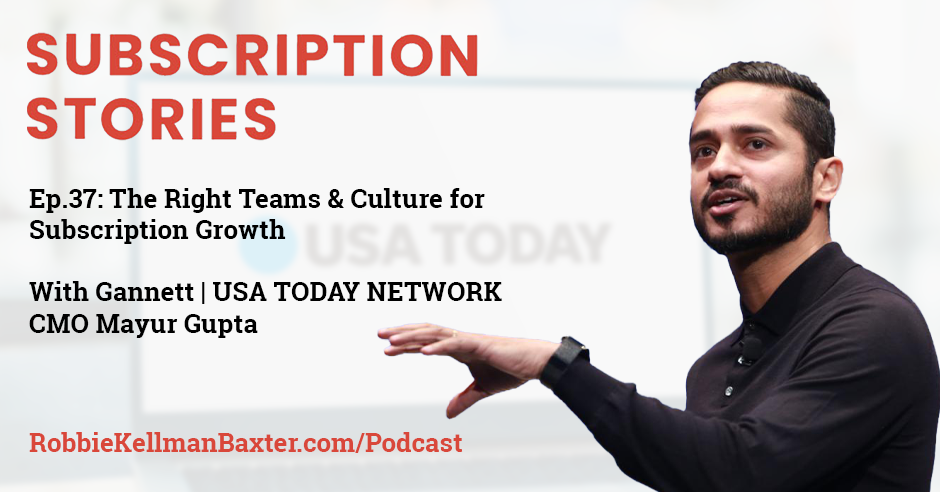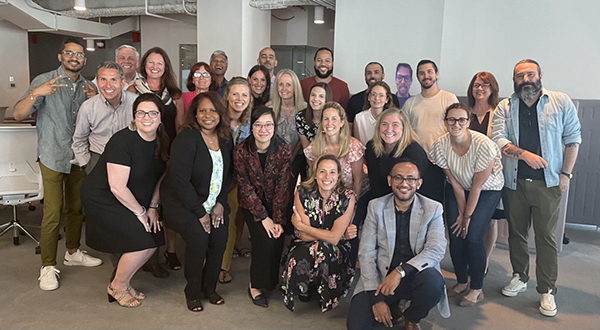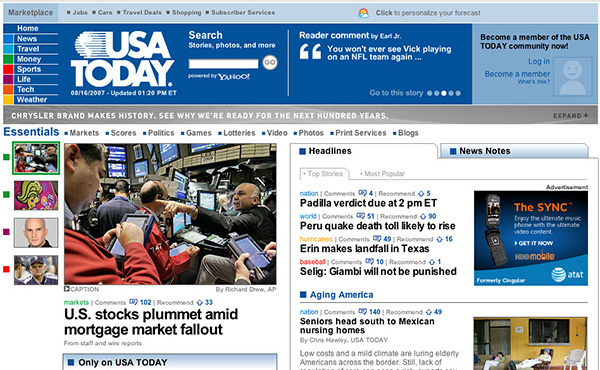
Mayur Gupta is the Chief Marketing and Strategy Officer at Gannett – USA Today Network. He is responsible for leading the transformation of Gannett into a subscription platform that is obsessed with user value and not just site traffic.
Mayur is responsible to actualize Gannett’s mission to build trusted local communities where people thrive. This is not his first time driving growth among subscribers. Prior to Gannett, he was CMO of the subscription meal company Freshly and before that, Mayur was Global VP for Growth & Marketing at Spotify.
Mayur was recently named to Forbes’ list of the World’s most influential CMOs of 2021.
In this conversation, we talk about the kind of teams needed for sustainable long-term subscription success, the role of “growth” as an emerging discipline and his formula for creating a flywheel for growth that can work at any kind of company.
—
Listen to the podcast here:
The Right Teams & Culture for Subscription Growth with Gannett-USA Today Network CMO Mayur Gupta
Mayur Gupta is the Chief Marketing and Strategy Officer at Gannett | USA Today Network, where he is responsible for leading the transformation of Gannett into a subscription platform that is obsessed with user value and not just site traffic. He is responsible for actualizing Gannett’s mission to build trusted local communities where people thrive. This is not his first time driving growth among subscribers. Prior to Gannett, he was CMO of the subscription meal company, Freshly. Before that, Mayur was Global VP for Growth and Marketing at Spotify.
I’m thrilled to talk with Mayur, who was named to Forbes’ List of the World’s Most Influential CMOs of 2021. In this conversation, we talk about the teams needed for sustainable long-term subscription success, the role of growth as an emerging discipline and his formula for creating a flywheel for growth that can work at any company. I hope you enjoy it.
—
I would like to open up with your journey since it’s a fascinating one and one that covers many of the big stories of the membership economy, leading to Gannett after stops at digital natives like Spotify and Freshly. Can you walk me through your journey, focusing on what you learned about sustainable growth at each stop?
Robbie, it has been a ride all right. I started my career as an engineer, growing up in India and did a major in computer science. That was the only way to get a job. I didn’t know any better. It evolved from there into product development then grew. Sometimes their context is helpful because I may not make a lot of sense as a marketeer.
Knowing that I’m an engineer by academic and DNA gives me a little bit of leverage. To answer your question on what I learned at those incredible stops at companies like Spotify and Freshly, my biggest take away working at an incredible organization, that became an iconic brand at insane growth, was one, there are no other modes than your ability to run faster than the competition.
Everything else is a commodity and to become a scale growth organization when you are a day one company, you have to believe in that mindset. You have to believe in the need for inertia and speed even when you reach scale. The flip side of that is when you run at that speed and pace, change becomes inevitable and constant change becomes inevitable, as well as healthy chaos. You need a culture where people feel safe and enjoy thriving in that healthy chaos, which is easier said than done.
There are two sides to the coin. When you are growing at a rapid pace, you are constantly disrupting your own self. You believe in the concept of testing and learning. You are almost in a state of constant paranoia but that also means you need an environment where it is okay to miss your OKRs. It is okay to fail now and then. You feel safe but you have tremendous transparency. There is tremendous communication internally. Otherwise, it creates unhealthy chaos and a lot of negativity within the environment and that makes it harder.
That healthy chaos, is that a culture you have seen at all of the organizations we mentioned, Spotify, Freshly, Gannett? Do you think it was a little different at Freshly and now at Gannett, a much more longstanding organization with a lot more history?

Subscription Growth: When you’re growing at a rapid pace, you’re constantly disrupting yourself. You believe in the concept of testing and learning. You’re almost in a state of constant paranoia, but that also means you need an environment where it is okay to miss your OKR.
An organization like Gannett, where I’m extremely proud to be a small part of, the journey to healthy chaos comes from a state of a lot of stability, vision, purpose and a hundred-year-old legacy. The reason why we believe in the state of healthy chaos, disruption and speed now are because we are trying to transform ourselves to address a fundamentally different business model. It is an evolution from a legacy media business driven by traffic to now becoming a customer-obsessed organization driven by user value and not just eyeballs and impressions.
That shift is coming from a very different starting point but arriving at that need for healthy chaos. As a matter of fact, we are manufacturing healthy chaos because we feel that is the only way we are going to move forward. Whereas in an organization like Freshly or Spotify, which have grown in this native digital world and they have gone from 0 to 1 and 1 to end, I think the healthy chaos is from the other extreme.
You start with unhealthy chaos and a lot of clusters. You realize you have to step back because now you have grown to a few hundred people, a few thousand people and it can’t be uncontrollable chaos anymore. When you are a startup of 5 to 10 people, uncontrollable chaos is a recipe for success. You are not going by swim lanes. You are wearing multiple hats. You can talk to every single individual. When you become $1 billion-plus in revenue or $500 million in revenue and a few hundred people, then you need to start reining in a little bit of freedom within the framework, but it can’t rein in all the freedom.
I want to make sure I understand. When you talk about this healthy chaos, healthy is about having some stability some structure that you are resting on that gives you the freedom to be chaotic. In longstanding organizations, they tend to be heavier on the side of stability with less chaos and innovation. On the other side, the startups that you have been fortunate to work with are great at making it up as you go, color outside the lines. They often need help creating that stability and security. As you pointed out, give people the confidence that the company is going to be here tomorrow even if I make a mistake or miss a number.
That’s spot on. It is in fact, way more eloquently put together. It is the oxymoron of healthy chaos and the two extremes coming together.
It is an interesting concept. I’m excited to be talking about culture. I think certainly in the world of subscriptions, a lot of organizations underestimate the importance of having the right culture for subscriptions, more specifically for building long-term relationships with customers. I would love to hear your thoughts on what, in terms of that culture you have described is especially important or relevant for businesses building a long-term relationship compared to a more transactional business model?
I could not agree more that if there was a time when culture could eat strategy for breakfast, lunch and dinner, it is now because it is so true and absolutely relevant in direct correlation to where the company is and what happens. The two parts of the culture, which I think are very important, Robbie, are the belief system and the values you bring as an organization that keep you on track towards your end goal, purpose and mission as an organization.
I say why that is so important is because we are living in a customer-led ecosystem. It is digitally native but we have never been customer-led. The customer has infinite choice and access, which means that in order for brands and businesses and whether you are in a subscription business model or otherwise. For you to own the right to win that customer, you have to fight hard every single time.
You have to drive incremental value to bring that person back one more time, which is the genesis of a subscription mindset. You cannot do that until you are customer-obsessed and focused on your purpose and mission. The customer nowadays because of that choice is so contentious. They can see through the facade and will leave you until you are absolutely authentic to who you truly are and your vibe behind the watch you sell and you produce.
There is no other mode than your ability to run faster than the competition. Everything else is a commodity. Share on XThat is more on the foundational level that you can’t fake your purpose and a promise anymore. You can perhaps bring somebody into your ecosystem once but in order for you to own the lifetime value, the relationship and the loyalty, you have to be there and keep raising the bar every single time.
How would you describe that promise? What is the promise that you make at Gannett or if you want to share the promises you made at the other organizations where you have worked?
For example, when I was at Freshly, our core promise within that category had been the three core pillars of healthy, tasty and convenient food. We felt that what made us unique was if you looked at the ecosystem, they were a lot of great solutions that we are solving for 2 of those 3 pillars. If you are healthy and tasty, you are not convenient. If you were convenient and tasty, you are not healthy.
If you order too many of the meal services, in some of those meal services the highest-grossing restaurant could be a fast food QSR, which we all know is not the healthiest place. Our value proposition was always the intersection of healthy, tasty and convenient. Convenient being accessible, affordable and so on. We knew that the only way for us to drive sustainable growth was not only to increase volume and reduce our CAC or improve retention but it was always staying true to that purpose and the mission.
We had to make sure that we were constantly innovating and investing in the quality of the food in standing up behind what we felt was going to be healthy for every individual and that was a journey. It is not like we cracked it open and we solved it all but there was a conscious investment we had to make. Based on the culture and the belief system, you make choices on where you want to invest.
When you are extremely transactional, you are purely focused on short-term KPIs and goals. You are living quarter over quarter. Inevitably, you make short-term choices for long-term losses or at the cost of a long-term promise or mission. Whereas sustainable growth companies somehow figured out a way to overcome short-term hits because they want to stay true to their long-term promise, purpose and mission. That correlates directly to that mindset of being a day one company, customer-obsessed because you are not just looking at the quarterly KPIs or the OKRs. You are committed to adding incremental value to your audience, giving them what they sometimes need even before they have asked for it.
What you said about that balance between those quarterly numbers and the long-term health of the business, I hope everybody reading takes that to heart. That is often a trade-off. When it comes up as a trade-off, you have to make the right choice. It sounds like that was a priority at Freshly. I know from talking to people in the past at Spotify, especially in the early days, there was a real emphasis on building long-term relationships even if they were free because of that long-term commitment. Do you want to share a little bit more about how you do that? How do you balance short-term versus long-term and keep the faith that it is worth it if you happen not to hit your quarterly number?
It is very hard, Robbie. I don’t want to be sitting here and say, “That’s the right thing to do and every business should do it.” What makes it harder is if you are a public organization. It is a benefit if you are private. It is a huge benefit if you are a startup because you have the runway. I feel very proud of this journey and connect, where we are trying to transform some iconic brands and legacy businesses with an incredible mission and purpose.
We are committed ourselves, especially in 2020, that we are going to evolve into a customer-obsessed organization. We had publicly shared our five North Star priorities, which is a part of our transformation. The number one of those North Star priorities was an intent to become customer-obsessed and a subscription-driven organization, no longer solely reliant on advertising revenue.

Subscription Growth: You have to drive incremental value to bring that person back one more time in one more time, which is the genesis of a subscription mindset. You cannot do that until you are customer-obsessed.
It is easy to pull it on a piece of paper and a deck but it is a fundamentally different mindset culture and definition of success. It pivots you 180 degrees on everything you do and we are committed to it. We have had to make some tough choices. As an example, we launched USA Today as a subscription business model. We had not done that for many years.
For decades, USA Today had been a free platform for the globe but we realized that while we will stay true to our purpose, there is a certain type of content, which will always be free because we have to fulfill our mission. At the same time, honest, authentic, unbiased, high-quality, premium journalism needs a different business model. We believe that as long as we hold ourselves accountable to add incremental value to our customers, they already pay for it.
You see those results. There’s no question that we have a lot of headwinds and will be a lot more curveballs thrown our way, but there is no question that we are going to stay true to that mission and the commitment. We know the end goal is raising the value and evolving this into a customer-led subscription model.
Many of us first got to know USA Today on the doorstep of our hotel room as a free paper. How are you handling that transformation? One of the big challenges that I see with a lot of organizations that have been around a long time especially news organizations is consumers have expectations. They have been receiving this brand in a certain way for a long time and advertisers too have been used to working with this brand in a certain way for a long time. How are you managing this transformation to being, as you said, a subscription first?
It is a journey, to begin with. It is not a flip of a switch where we went from a completely free product to an entirely behind the paywall or a premium product. We have applied a lot of lessons, Robbie, that we have learned through the rest of the ecosystem, which is a portfolio of 250 local brands that went subscription-led a few years back. We have learned a lot through that ecosystem, which is now being applied to our most iconic national and global brand, which is USA Today,
First of all, it is a journey and we’ve taken incremental steps. We applied a lot of lessons learned that many other products, SaaS and subscription companies to. We are testing, learning and relying a lot on our research, talking to a lot of customers, call and cont and doing a number of experiments to what data we now understand.
What are the types of content that our existing USA Today readers are ready to pay for? When I was coming into the category as a newbie, I realized there was a period where we all were consuming news on social platforms like Facebook and others. One thing that I have learned in the last few years is there is a blessing in disguise there that access to free news comes at the cost of authenticity and reliability. There is a significant TAM in the world that is ready to pay for high-quality premium journalism. There is no question about it.
TAM being Total Available Market?
Total Addressable/Available Market, yes. The size of the market across the globe within the United States is too substantial because people have seen what happens when you rely on inauthentic, invalidated content and news. It leads to a lot of chaos and mess at a national and global level. It gives us an opportunity, a responsibility to make that evolution and raise the bar in terms of the value we take back.
A couple of the key points that you bring up that I want to highlight. One of them is all of the experimentation you are doing, both the experimentation you did with your smaller brands to build the subscription muscle, the understanding of how subscriptions work and the confidence that it could work, and the continued experimentation and market research that you are doing as you transform the iconic brand to be more subscription first or obsessed.
If there was a time where culture could eat strategy for breakfast, lunch, and dinner, it is now. Share on XYou have said that the more obsessed with user value and not just traffic. Those are some important points. One question I wanted to ask you is I think you have been going out for a few years leading this transformation. What about the team? I’m interested in, as we are going through our conversation is culture and people. What team do you need in order to build this model and to support subscription-based growth? You have a team with growth strategists, brand and performance marketers, data scientists and product managers. What advice do you have? How do you think about the right team for this business model and customer-obsessed approach?
I’m a big fan of thinking about people and teams. Every outcome is eventually a function of the talent and the leaders you bring onboard. Equally important is how you organize and operate because your end-user experience at the end of the day is a reflection of your organizational model. The two ways I would love to address that, Robbie, one is the way I think about growth is three-fly wheels, which are overlapping. They are growing the brand, the user base and the user value.
I believe sustainable growth is not a choice between growing the brand or growing the user base. In a lot of early-stage companies, there is always a choice between, “Let’s put $100 out of the $100 in acquisition. Let’s invest everything in the product. We ignore the value of building a strong, authentic, purpose-driven brand.” In the early stages, from 0 to 1, it absolutely works but investing in the brand is the flywheel of creating new demand. It is the process where you soften the ground within that total addressable market to bring in growth segments that don’t believe in you yet. Perhaps they don’t even believe in the category.
Maybe they don’t understand it yet. They are not going to come to you because you have a product that works great for the core audience. They won’t come to you because you threw an offer. It is very important when we think about outcomes, we do invest and believe in the outcome of the brand because it helps you expand your addressable market to soften it so that you can pull those users in when you saturate your existing market and town.
With that in mind, the way I think about the organizational structure is, first and foremost, that sustainable growth happens at the intersection of marketing product, content, data and science. There are many variations of growth models and organizational structures. You can make a growth team sit anywhere you want. There are companies especially on the West Coast, in Silicon Valley, where growth teams are standalone teams.
There are organizations where growth reports into product, and mostly direct-to-consumer businesses that a growth team reports into marketing because marketing is not accountable for a brand. They are accountable for numbers, AOEs and LTVs and so on. Regardless of where you make a growth team sit, in the end, the growth team still is a function of analysts, data scientists, product managers, people who are building products. These marketers are thinking about taking it to market.
Content writers, if you are in the content business, it also becomes your core product. No matter how you organize, the only way you are successful is to create an operating model where all these functions come together and have a shared outcome. It can be OKRs or any other template. They work together to solve that problem. In our case, we brought on some lessons that I learned back in my day at Spotify. We brought on the concept of squads, tribes and chapters.
We have adopted OKR across the organization, for example, but very simply a squad or a pod is a small unit, an autonomous unit, with a mix of engineers, data scientists, product managers, marketers, copywriters with a shared outcome and objectives. It is a cross-functional unit. While in the evening, they may belong to a tribe, a tribe of engineers, data analysts or marketers. During the day, they all have a common set of objectives and chaos.
That is what they are coming together to address because the customer experience or the key customer experience happens at that intersection. The operating model has to enable that partnership, that collaboration. The operating model has to break down the traditional silos, where the product is working on a product idea and they throw it over the fence to marketing once it is baked in to say, “Now go market it,” or do a campaign. We all know that it doesn’t work but 8 over 10 times, that is still the model that happens where we are operating in those buckets and silos.

Subcription Growth: In order for you to really own the lifetime value, to really own the relationship and the loyalty, you have to be there every single time and to keep raising the bar every single time.
I appreciate the specificity about how you described the by day and by night. You are part of this tribe, “I’m a marketer or I’m a product manager but my allegiance is to this squad and our shared metrics, OKRs.” I think that it is easier said than done because it is a different way of structuring the organization. I’m putting my own perspective and you can disagree if you want. I would welcome your feedback.
When you are thinking about a member’s journey, in your case, your readers, audience, it is very hard to break it down and say, “The marketing part happens here and the product part happens there.” It is all happening at the same time. Everybody has to be thinking about the whole experience. I worked with one company many years ago in the media space. The general manager said, “The acquisition team was doing a phenomenal job because people were signing up and the retention team was doing a terrible job because people were leaving.” The offer that the acquisition team was presenting was, “Come get this one piece of content.” It emphasizes how important this concept of pods or squads is to achieving shared goals.
That single-handedly, Robbie is one of the quintessential needs for growth companies is to have the concept of shared outcomes and objectives. I have seen so many growth companies in the early stages because it is growth at all costs where exactly that use case where you bring scale acquisition but retention struggles. The retention person is pointing the fingers at the acquisition team saying that you brought on users at very high discounts so they are low-quality users. They are coming for the value of the discount, not the value of the product.
Within the acquisition team, you could have pieces of the funnel that are owned by the product team. The acquisition person is saying, “The CPL, Cost Per Lead and Cost Per Checkout Page, for example, that is the last step.” That is all brilliant. I have a massive drop-off on the checkout page. I have a massive drop-off on onboarding. It is your problem. There are so many teams that still struggle with that. That is why you maximize the outcome when we align people with different skillsets, functional allegiance but align them towards the same definition of success, the same outcomes and objectives.
Are the squads or tribes divided by those three parts of the growth flywheel? Does each squad or pod have responsibility for all three some metrics around a brand, user base and then increasing value?
There is no single answer. I think we all would create our own definition of abstraction. How big do you want the pod to be? There are some guidelines and best practices that I have learned. You don’t want the pod to be a unit of twenty teams because it becomes too big. You also don’t want to be too narrow because then you will have new fragments. In our case, for instance, we have an acquisition pod but because we also have multiple products, we launched sports plus products for our six local markets.
That in itself is a pod because the customer or the audience is so unique and different. We are now diversifying and expanding much younger. The needs, the content curation process are very different. The KPIs, the onboarding and the experience of the product itself are very dramatically different. It is a lot more leaning on our younger audience and demographic compared to USA Today for a very different reason. It is a whole functional pod that includes both acquisition and retention because it is in the early stages.
As we scale it, we are likely going to separate apart acquisition so that part can diversify channels, diversify the audience segmentation, whereas retention will have its own set of challenges at scale. It all depends on the diversity, the challenge of what you are trying to solve. Based on that, you determine is that one pod or multiple pods? The one small thing, Robbie, if I can add to your first question is that it is very relevant, especially to Gannett in terms of the team structure and the talent.
That has been a huge focus area for us in 2021. We have been firm believers that if we have to transform ourselves from a 100-year-old iconic brand to a disruptor, we can’t do it organically because we don’t have the timeframe. We brought on some incredible leaders who have disrupted different categories, coming with no baggage and challenging the status quo.
Sustainable growth is not a choice between growing the brand or growing the user base. Share on XThey are coming in on day one, telling us what needs to be done. We brought on people from the likes of Spotify, Peacock by NBC, Aura, Ollie, from all kinds of different either subscription businesses, non-news content businesses, from FinTech and they are coming in, looking at the model and helping us transform and gain speed.
I think you and I share this point of view that bringing people from different industries is tremendously valuable. It brings new ideas, perspectives and deep expertise in the core skill areas for a subscription or customer-centric business. We are coming up to the end of our time and I’m wondering if you are okay with doing a speed round.
Sure. Let’s do it.
What is the first subscription you ever had?
It was Spotify.
What is your favorite way to consume news?
It is the truth. I still consume a lot of news on an Indian app called Times of India. I grew up there and my second favorite way is USA Today.
Is it print, digital or a combination?
It is all digital unless I’m visiting my dad in India. I love to read the newspaper there but when I’m here in my house, it is all digital.

Subscription Growth: That sustainable growth happens at the intersection of marketing product, content, data and science.
What is your favorite Freshly meal?
It is used to be the Buffalo chicken. I haven’t had that in a while but that was my favorite Freshly meal.
What is the biggest tip for building sustainable growth whether or not you are interested in subscriptions?
Believe in speed over perfection, be customer-obsessed, and break down the organizational silos.
Finally, other than the organizations where you have worked, what is your favorite subscription that you use now?
Hands down, Netflix. I’m a movie and a TV buff. I can’t tell you how many hours I spend in a week in front of my Netflix subscription account.
We share that. Thank you very much for all of the insights. I appreciate your time and your thoughtful comments. I’m looking forward to talking again very soon.
Thank you, Robbie. Thanks for having me over.
—
That was Gannett | USA Today Network’s, Mayur Gupta. For more about Mayur and Gannett, go to Gannett.com. For more about subscription stories, as well as a transcript of my conversation with Mayur, go to RobbieKellmanBaxter.com/podcast. If you like what you heard, please go to Apple Podcasts or Apple iTunes and leave a review. Mention Mayur and this episode if you especially enjoyed it. We read all the reviews because we want your feedback. Thanks for your support and thanks for reading the Subscription Stories.
Important Links:
- Mayur Gupta, Chief Marketing and Strategy Officer, Gannett
- Gannett | USA Today Network
- Freshly
- Spotify
- Article on Forbes’ List of the World’s Most Influential CMOs of 2021
- Peacock
- Aura
- Times of India
- USA Today
- Netflix
- Ollie
About Mayur Gupta
 Mayur Gupta is the Chief Marketing and Strategy Officer at Gannett – USA Today Network where he leads a team of strategists, brand marketers, growth hackers and data scientists to drive the company’s transformation from a news media platform to a digital content subscription marketplace. He is responsible to actualize Gannett’s mission to build trusted local communities where people thrive.
Mayur Gupta is the Chief Marketing and Strategy Officer at Gannett – USA Today Network where he leads a team of strategists, brand marketers, growth hackers and data scientists to drive the company’s transformation from a news media platform to a digital content subscription marketplace. He is responsible to actualize Gannett’s mission to build trusted local communities where people thrive.
Prior to that, Mayur Gupta was the Chief Marketing Officer at Freshly where he led a team of brand marketers, growth hackers and data scientists to make Freshly an iconic lifestyle brand while driving breakthrough business growth. He was responsible to actualize Freshly’s mission to breakdown the barriers for healthy eating and inspiring a hundred million people to unlock their full potential.
Prior to that, Mayur was the Global VP for Growth & Marketing at Spotify. He was responsible for driving growth for Spotify across MAU, DAU & paid subscriptions by leveraging data driven always-on experiences; testing new business models, partnerships and engagement strategies along with establishing marketing capabilities for fans, artists and B2B brand partners.
Mayur has been nominated by the Forbes Magazine as one of the Top 50 Most Influential CMOs in the World each year since 2019.
Love the show? Subscribe, rate, review, and share!
Join the Subscription Stories Community today:


